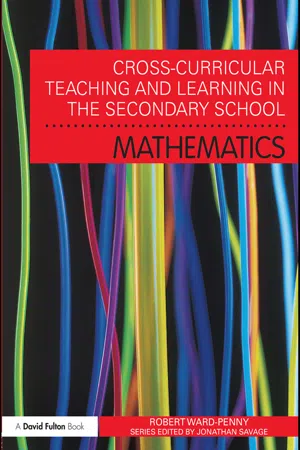Flow Charts
Flow charts are visual representations of a sequence of steps or processes. In mathematics, flow charts are often used to illustrate algorithms or problem-solving procedures. They use different shapes and arrows to show the flow of information or decision points, making it easier to understand and follow the logical progression of a mathematical problem.
4 Key excerpts on "Flow Charts"
- Robert Ward-Penny, Jonathan Savage(Authors)
- 2010(Publication Date)
- Routledge(Publisher)
...Flowcharts and algorithms are explicitly considered in ICT as part of the process of software design, and they can also feature in supporting documentation. For instance, a flowchart might show the algorithm a control system in an automated greenhouse follows when it interrogates a sensor in order to decide whether the temperature is too low, and what action it takes based on this reading. Algorithms also play a key role in many computer programming languages. Algorithms and flowcharts also feature throughout the mathematics curriculum. Whilst not all schemes and syllabuses explicitly teach using these terms, many do, and all implicitly require pupils to be able to follow an algorithm. For instance, the column method of adding a pair of numbers together is most often taught as an algorithm (see Figure 7.1), as is the procedure for adding two fractions together. Flowcharts can also provide an excellent way of communicating iterative or recursive procedures. The topic of algorithms is dominant in A-level option modules that are focused on decision, or discrete mathematics, wherein pupils learn algorithms for optimising revenue, finding a critical path when managing a project and identifying the shortest path that connects two points in a network. The idea of an algorithm is powerfully cross-curricular, and moving between subjects can reinforce pupils’ understanding of what an algorithm is and help to develop their ability to deconstruct a process in a thorough and logical way. As we become an increasingly technological society these skills will become more important in the workplace, not only for those working to design technology, but for anyone who has to use it in an efficient, safe, and reliable way. Figure 7.1 A flowchart of the column addition algorithm. Reflective task To develop pupils’ ability to work with algorithms, it is useful to give them practice at both applying and designing their own algorithms...
- eBook - ePub
The Innovation Tools Handbook, Volume 2
Evolutionary and Improvement Tools that Every Innovator Must Know
- H. James Harrington, Frank Voehl(Authors)
- 2016(Publication Date)
- Productivity Press(Publisher)
...It is also used to study a proposed solution to define weaknesses, improve on them, and document the final solution. • Value proposition phase—During the value proposition phase, flowcharting is frequently used to analyze and understand the proposed process. It is then used to calculate key parameters like cost, cycle time, and risk. • Resourcing phase—During this phase, the flowchart is an effective tool for doing activity-based costing and costs–benefits analysis. • Documentation phase—During this phase, flowcharting is often used as a key part of the operating instructions and workflow diagrams. • Production phase—During the production phase, flowcharts are frequently used to communicate the sequence of operations that are required to produce the end output and to communicate key information to the individuals performing the activities within a complex process. HOW TO USE THE TOOL Flowcharting is a method of graphically describing an existing or proposed new process by using simple symbols, lines, and words to pictorially display the sequence of activities. Flowcharts are used to understand, analyze, and communicate the activities that make up major processes throughout an organization. They are essential tools used in process redesign, process reengineering, Six Sigma, and ISO 9000 documentation. General There are many different types of flowcharts. It is important that the practitioner select the best one for the specific application (see Table 8.1). Preparation Flowcharts have application in almost all parts of problem-solving and innovative processes. They are useful for identifying problems, defining measurement points for data collection, idea generation, and idea selection...
- eBook - ePub
Auditor Essentials
100 Concepts, Tips, Tools, and Techniques for Success
- Hernan Murdock(Author)
- 2018(Publication Date)
- Auerbach Publications(Publisher)
...Chapter 50 Flowcharts Drawing flowcharts can be time consuming, but internal auditors can gain a wealth of information during and after preparing them. Flowcharts can contain up to three dimensions of data and by layering information, each dimension adds new details that provides deeper insights into how a process operates and where opportunities for improvement lie. A flowchart is a type of diagram that represents a workflow or process. It shows the two most common items in a flow: Processing steps (as boxes) and Decisions (as diamonds). The order, or sequence, of the various activities is shown by arrows and they are used to design, analyze, document, and manage processes. These flowcharts answer the question: What Happens? A flowchart can also be cross-functional by dividing the diagram into swimming lanes. Each lane represents an individual or organizational unit performing the activities within that lane. This approach allows internal auditors to identify responsibilities because it shows who performs an activity or makes a decision. These flowcharts answer two questions: What Happens? and Who Does It? Flowcharts can also add a third dimension by showing the cycle times involved. This includes the amount of time the entire process takes from beginning to end, how much time each step takes (i.e., “the time in the boxes”), and the amount of time waiting or in transition between steps (i.e., “the time between the boxes”). By understanding the time element, internal auditors can better understand the speed, bottlenecks, and delays in the process. When all of the time “inside the boxes” is added, it represents the value-add time during the process since this time is spent processing transactions and performing activities. When all of the time “outside the boxes” is added, it generally represents the non-value-add time because it is the time spent waiting and transporting...
- eBook - ePub
A Manager's Guide for Better Decision-Making
Easy to Apply Tools and Techniques
- Abu S.M. Masud(Author)
- 2021(Publication Date)
- CRC Press(Publisher)
...2 Tools for Problem Analysis DOI: 10.1201/9781003172291-2 2.1 Introduction An important step in any problem solving is analyzing the perceived problem for a better and clearer understanding of it. In this chapter, we will explain some commonly used tools for problem analysis. Not all these tools will be applicable nor needed to be used in every problem the Decision-Maker (DM) would encounter. Ishikawa (1982) has more detailed discussions about some of the analysis tools described later. 2.2 Flowchart A process is defined as a series of actions taken to produce a specific output (e.g., an ordering process) and a process flowchart is a graphical illustration of the process that shows the interrelationships among the tasks as well as the tasks themselves. A process flowchart is a visual communication tool used for process definition and understanding. It can be used to identify critical points in the process where problems occur and where the DM may need more information. In a specific problem solving situation, multiple flowcharts may be created: one for the initial problem and others for the proposed solution alternatives. Creating a process flowchart consists of the following steps. Step 1. Process Identification and Clarification. In identifying the process to be studied, DM needs to be as specific as possible to the area to be improved or corrected. Usually, it is better to start with a broad area of the problem and then focus on specific steps for more details as needed. The identification process clarifies what the process is supposed to accomplish, and its start and endpoints. The questions to be asked in this step are: Who is the process owner? The process owner is that individual who has the authority or ability to make changes. Who are the customers? Customers are the recipient of the outputs of the process...



